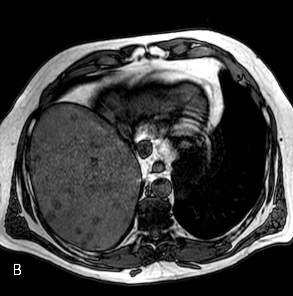
Visible spots on the liver appear using medical imaging technology (ultrasound, CT scan, MRI, etc.). Normally, the liver has a smooth, uniform appearance in images generated by such techniques. When spots or discolorations appear, this can be a sign of various liver disorders ranging from benign tumors to inflammation to cancer.
Although not universally a sign of liver cancer, spots on the liver are always a cause for medical concern and an indication that further diagnostic procedures should be conducted. Even where liver cancer is not present, the condition may (depending on circumstances) be dangerous and treatment may be indicated.
Non-
Hemangioma
There are several kinds of non-
Hemangioma is one of these and indeed hemangiomas are the most common non-
Liver Adenoma
Liver adenoma is another and much less common type of non-
Unlike hemangioma, liver adenoma often has overt symptoms, usually pain in the area of the liver. Liver adenoma may on rare occasions develop into liver cancer. Also, large hepatic adenomas have a tendency to rupture and bleed profusely into the abdomen. For these reasons,
resection of all liver adenomas is recommended where feasible.
Granuloma
A granuloma is a mass of inflamed liver tissue. It represents an immune-
Cancerous (Malignant) Tumors
Spots on the liver can also indicate the presence of any of several types of liver cancer. Of course, that is a cause for great medical concern, as is almost always the case with cancer. Liver cancer may be primary or metastatic.
Primary Liver Cancer
Liver cancer can arise as a complication of other liver diseases such as hepatitis or cirrhosis of the liver. Risk factors also include alcohol abuse and excessive iron consumption. An estimated 24,000 cases of liver cancer are diagnosed annually in the U.S. Unfortunately, liver cancer is usually asymptomatic until the advanced stages of the disease, making monitoring of liver enzymes and follow-
Treatment of primary liver cancer in the early stages is likely to involve surgery and sometimes chemotherapy. In later stages, liver cancer that has not metastasized may be treated by a liver transplant, which removes the cancerous tissue and replaces it with a new, functioning liver.
Secondary (Metastatic) Liver Cancer
Metastatic liver cancer refers to cancer of the liver that began in another part of the body and spread to the liver. The most common cancers to spread to the liver are lung, colon, breast, and pancreatic cancers. Metastatic liver cancer is more common than primary liver cancer, and is an ominous development, as it indicates an advanced stage of cancer in the original host organs. Also, cancer that metastasizes to the liver may also spread to other parts of the body. Cancer that has metastasized from anywhere to anywhere else is always harder (and sometimes impossible) to cure than cancer that is detected before this takes place. Surgical treatment for metastasized cancer is usually not feasible. Chemotherapy is the recommended procedure and has only a limited success rate.